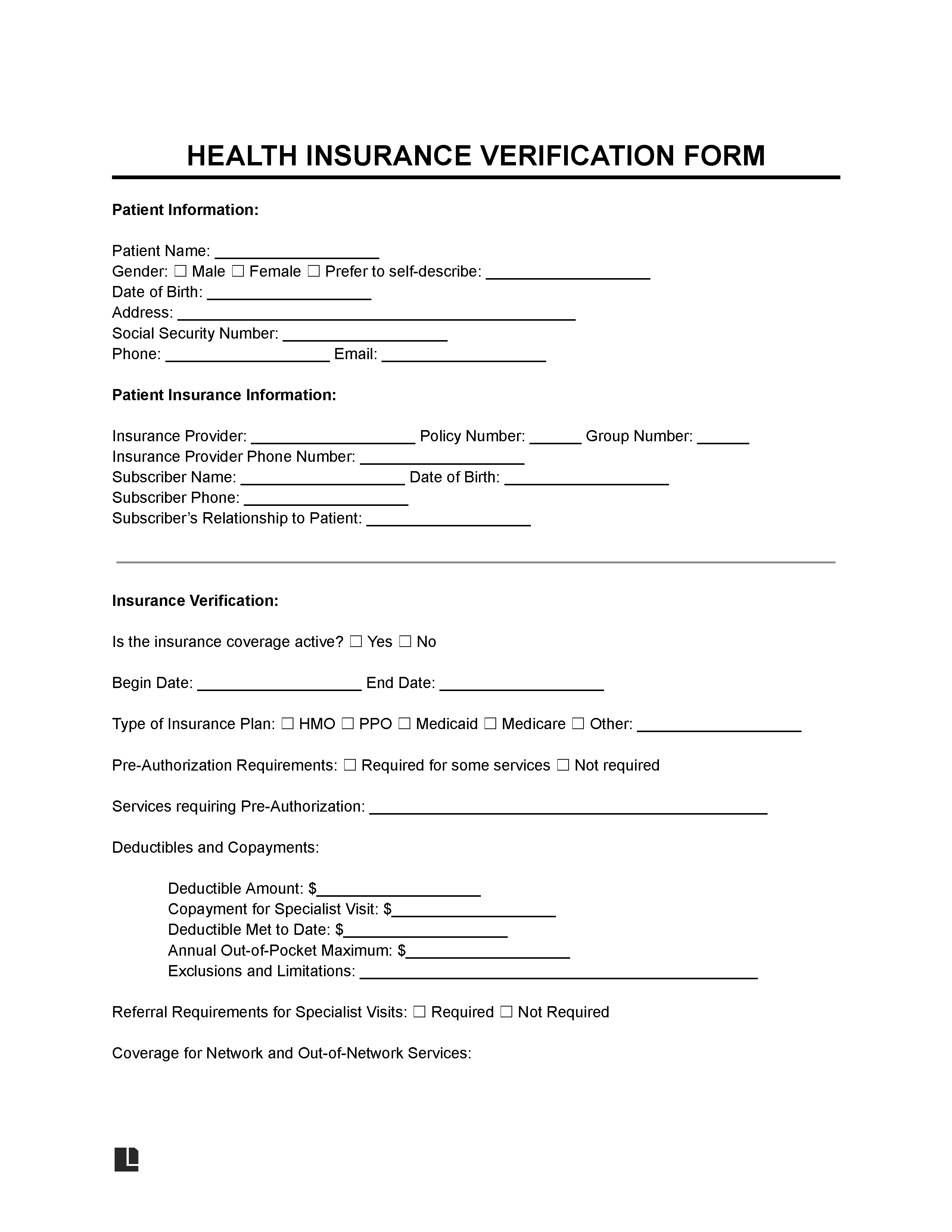A medical (health) insurance verification form is a document healthcare providers use to verify a patient’s type and extent of health insurance coverage. After the medical facility sends the form to the patient’s insurance provider for completion, its office staff can review it to determine which services the patient’s insurance will cover.
Benefits of Verifying Health Insurance
- Confirms Coverage: This form verifies that the patient’s insurance plan covers the scheduled services. It helps ensure compliance with insurance requirements and prevents coverage issues.
- Streamlines Processes: It minimizes errors and delays in billing and claims processing.
- Improves Patient Satisfaction: This form establishes trust, promotes transparent communication, and improves the patient’s experience.
- Facilitates Preauthorization: If you need preauthorization for specific treatments of procedures, this form can help you obtain them.
What You Need for Health Insurance Verification
As a healthcare provider, you’ll need the following information to complete your portion of a health insurance verification form:
- Patient data: Request the patient’s full name, date of birth (DOB), address, contact information, and social security number (SSN).
- Insurance information: Collect the patient’s primary insurance company, policy number, group number, insurance contact information, subscriber’s name, subscriber’s relationship to the patient, and plan type (HMO, PPO, etc.).
- Health coverage: Acquire the information regarding the patient’s health coverage, including the covered services, out-of-pocket limit, copayment, coinsurance, and deductibles.
- ICD-9-CM codes: Obtain the unique diagnosis codes identifying the patient’s health issues. For example, 786.50 identifies unspecified chest pain, while 599.0 identifies a urinary tract infection at an unspecified site [1] .
- Expected CPT codes: Record the Current Procedural Terminology (CPT) codes, ranging from 00100–99499, that relate to each service or procedure the medical facility may need to provide to the patient.
How to Verify a Patient’s Medical Insurance
Step 1 – Collect the Patient’s Information
Ask the patient to provide their information, including their personal details and health insurance information. You may also ask for the patient’s medical history to determine the services they may need.
Request this information several days before their first appointment if possible, as this advanced planning allows time for the insurance company to complete the insurance verification process.
Step 2 – Contact the Insurance Company
Contact the insurance company to get in touch with a representative. Refer to the patient’s insurance card, as it will often list a designated service line that the insurance provider reserves for verification. You may also have the option to visit the insurance company’s online portal to verify coverage.
Before Sharing a Patient's Information
Always obtain a patient’s permission before sharing their information with an insurance company or another third party. Ask the patient to complete a medical records release authorization form to document their consent in writing.
Step 3 – Check the Coverage Details
Once you connect with a representative, ask them to verify the patient’s insurance details. Some information they will verify includes the patient’s cost-sharing obligations, insurance benefits, deductibles, and other policy details.
Step 4 – Verify Eligibility
Ensure the patient is eligible for coverage on the desired date of service. Since coverage can change, it’s important to verify eligibility for each appointment. Some insurance companies may require preauthorization for specific services (like providing durable medical equipment or prescribing some medications).
Step 5 – Record the Insurance Details
Record the insurance details on your verification form. This way, you’ll have them readily available for billing and reference purposes.
Information to Record
Along with the details of the patient’s insurance policy, you should also include the name of the representative you spoke with, the date and time of verification, and any reference or approval numbers or codes.
Step 6 – Follow up with the Patient
Once you complete the verification process, contact the patient to inform them of what their health plan will cover. Explain what amount they may have to pay out-of-pocket and if their insurance provider requires prior authorization to seek reimbursement.
Health Insurance Verification Form Sample
Download a health insurance verification form template in PDF or Word format below:

Frequently Asked Questions
Should I verify a patient’s insurance before their office visit?
Verifying a patient’s insurance coverage before their office visit is ideal, but it’s not required. Doing so confirms that they have valid insurance and prevents identity theft and fraudulent claims.
Furthermore, when you seek verification from a patient’s insurance provider, you can understand what services the provider will and won’t cover. This way, you can offer higher-quality care and a more efficient experience for the patient.
How often should I verify a patient’s insurance coverage?
If possible, try to verify a patient’s health insurance every month. This way, you can get updates on changes to their deductible levels or coverage.
Who verifies a patient’s medical insurance?
The medical or healthcare provider is responsible for verifying a patient’s medical insurance before offering services.
What happens if I don’t verify a patient’s insurance?
Failing to verify a patient’s insurance may result in a medical facility not receiving payment for their services. They may also receive delayed or incomplete payments.

